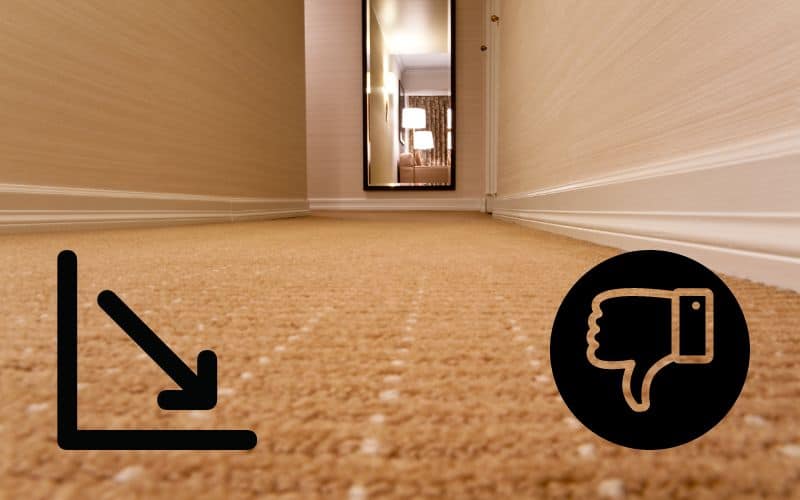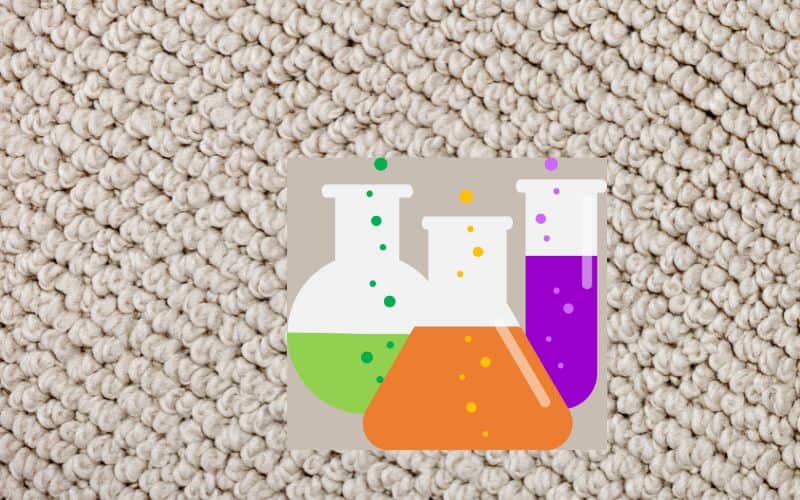The Pros and Cons of Eco-Friendly Carpeting (Why Consider)

Carpets are a popular choice for flooring since they’re soft, warm, and silent.
However, most of them aren’t made using environmentally friendly materials and practices.
This doesn’t mean you should forgo using carpets, but it may push you to look for options that provide the same benefits — just without the same environmental concerns.
Eco-friendly carpeting is made of organic, natural, and sometimes recycled material. It is sustainable, non-toxic, and produced in a way that reduces emissions and waste. However, some types of eco-friendly carpeting are not biodegradable or include non-sustainable carpet backing.
In this article, I’ll discuss the benefits and disadvantages of environmentally friendly carpeting that the carpet industry offers.
I’ll also provide tips for environmentally friendly carpeting and suggest the best companies that produce sustainable carpets.
So, read on to find out more.
The Pros of Eco-Friendly Carpeting

There are numerous reasons more people are turning to environmentally friendly carpeting as a home flooring choice.
Let’s explore the benefits of this type of carpeting below:
Environmentally Friendly Carpeting Is Sustainable
Environmentally friendly carpeting is made of recyclable or biodegradable materials. Therefore, it won’t harm the environment as regular carpets do.
Environmentally friendly carpeting companies offer carpets and rugs made of sustainable materials like:
- Organic wool
- Organic cotton
- Jute
- Seagrass
- Recycled plastics
- Nylon blends
Some companies even claim that their carpets are so biodegradable that they can be recycled in your yard by simply putting them on the soil and allowing them to break down naturally, providing nutrients for your garden.
Of course, before you purchase from these companies, research the materials of the carpets they sell and check if they do actually biodegrade faster than traditional carpeting materials.
Additionally, the manufacturing practices used to make carpets also matter. It can’t be an environmentally friendly carpet if it’s made by wasting resources and polluting the air, no matter how sustainable the material itself is.
Therefore, companies that produce environmentally friendly carpeting are certified by the proper authorities for their environmentally friendly production process.
Environmentally Friendly Carpeting Limits Exposure to Toxic Materials

Synthetic carpets are treated with certain chemicals (such as volatile organic compounds) to make them more durable, fire resistant, stain resistant, and protect against mites, mold, and other living organisms.
However, these chemicals can create potentially dangerous fumes for people living in the same area. They can cause issues with the respiratory and nervous systems.
On the other hand, environmentally friendly carpeting companies have policies regarding harmful chemicals.
They aim to limit their use as much as possible to offer healthier, chemical-free alternatives made from natural fibers. This is a significant advantage of environmentally friendly carpeting since it will improve the indoor air quality of your home.
Environmentally Friendly Carpeting Is Very Durable

Some environmentally friendly carpets are incredibly durable and can last for decades. Manufacturers aim to make these carpets resistant to the ravages of time, so they don’t need to be replaced often and can be maintained easily.
Furthermore, the high-quality materials used to make environmentally friendly carpeting can have better stain resistance than synthetic materials. These features allow it to last longer and stay in better condition than a typical nylon carpet, making it ideal for high-traffic areas where hardwood flooring might otherwise be the best choice.
Their excellent durability can even cost less in the long run.
Environmentally Friendly Carpeting May Be Less Expensive Than Others
Some sustainable materials used to make environmentally friendly carpeting are also less expensive than alternatives.
Seagrass and jute, for instance, are among the cheapest flooring options.
By using environmentally friendly carpeting, you can enjoy all the benefits mentioned above for a lower price.
All you need to do is find the right companies that guarantee environmentally friendly materials and practices.
The Cons of Environmentally Friendly Carpeting

Some environmentally friendly carpeting contains less environmentally friendly materials, such as synthetic carpet materials, and the above benefits don’t apply to them.
Here are a few things you should be aware of:
The Carpet Backing Is Not Always Eco-Friendly
The materials used for the carpeting may be sustainable, but the backing pads are often more harmful to the environment.
Carpet backing is generally made with thermoplastics, polyurethane, latex, and more. These materials are non-sustainable, and some of the ingredients for making them are toxic to the environment.
Therefore, carpet backing is vital to consider when choosing environmentally friendly carpeting.
Some Eco-Friendly Carpets Are Treated With Chemicals

One of the most significant advantages of environmentally friendly carpeting is that they’re made of natural ingredients and not treated with many chemicals.
However, check if carpeting companies emphasize that they don’t use chemicals rather than just mentioning sustainable materials.
Sometimes, carpeting made of sustainable or natural materials is still treated with chemicals.
For example, organic wool carpets or cotton may be treated to resist insects or bacteria.
Additionally, the chemicals in wool carpets can even come from the source since sheep are often treated with chemicals to fight parasites.
Not All Eco-Friendly Carpets Are Biodegradable
While all the materials used in certified environmentally friendly carpeting are sustainable, not all are biodegradable.
For example, materials like recycled plastics are sustainable when their manufacturers use practices that save energy and reduce emissions.
However, plastics still aren’t biodegradable within a short enough time to be environmentally friendly.
Carpeting made of recycled plastic ensures the material is being reused, but once it’s unusable, it will take thousands of years for it to break down, which is not what one looks for in environmentally friendly materials.
Environmentally Friendly Carpets May Be More Expensive Than Others

Jute and seagrass are pretty cheap, but other environmentally friendly materials are not.
Organic wool carpeting, for instance, is an excellent option for environmentally friendly carpeting. It’s resistant, long-lasting, and not treated with chemicals.
However, it’s one ofthe most expensive options, even compared to non-sustainable carpeting. Materials like wool are not easily affordable, especially for large areas.
Best Eco-Friendly Carpeting Options

Now that you know all the potential pros and cons, you can start looking for environmentally friendly carpeting options that suit your requirements.
Several companies offer carpets made of sustainable materials. Here are a few:
Nature’s Carpet
Nature’s Carpet offers dozens of carpet colors and styles. Some are made of 100% organic wool, while others are made of top-quality wool carpeting blends.
Rest assured that these carpets aren’t treated with toxic chemicals and include backing made of natural latex.
Understandably, Nature’s Carpet products are costly, considering they’re made of high-quality wool carpeting, but there are also budget-friendly options.
Interface
Interface is one of the most environmentally friendly companies in the world.
Their dedication to sustainability has led to creative ways of using old materials to create high-quality and beautiful carpeting.
By reusing old carpets and waste yarn, Interface reduces emissions and saves energy.
FLOR
FLOR makes carpet tiles out of recycled nylon, PET, and other materials.
The process of making these tiles is incredibly efficient, wasting minimal amounts of energy and water. Additionally, FLOR carpeting meets the standards of the Carpet and Rug Institute (CRI) for emissions.
You have countless styles, patterns, and colors to choose from. Also, if you need to get rid of your FLOR carpeting, you can mail it back to the manufacturer for recycling.
Earth Weave
Earth Weave is the first company in the United States to make carpeting with 100% natural carpet fiber.
Their wool carpet is made of organic wool and natural rubber and aren’t treated with chemicals. All the materials, including the backings, are 100% biodegradable.
You can choose carpeting from the Bio-Floor Collection, which features products made of undyed wool carpet, but you can also select naturally dyed wool carpeting, which contains no chemicals.
Mohawk
Mohawk doesn’t specialize in environmentally friendly carpeting, but it offers the Eco-Chic line, which includes carpets made of verifiable recycled materials.
The Eco-Chic line carpets are sustainable and non-toxic, so they won’t affect the air quality inside your home.
Eco-Friendly Carpeting Tips

When looking for environmentally friendly carpeting, you should have specific criteria to help you find the right option. Here are some tips:
- Consider ALL the materials. The carpet material is crucial, but don’t forget the carpet backing, and packaging a new carpet comes with. If only the carpet is friendly to the environment but not everything else, that’s a sign that the seller isn’t wholly committed to eco-friendliness.
- Check for certifications. Companies that meet the required environmental standards can be certified by the appropriate bodies, such as the carpet and rug institute, which will include the certification on their labels and websites. Some certifications include CRI’s Green Label Plus Certification, its Sustainable Carpet Standard, and the Cradle to Cradle Certification.
- Don’t hesitate to replace existing non-eco-friendly synthetic carpets. It’s never too late to switch to sustainable carpets. Your old carpet may be treated with chemicals that are incredibly harmful to you, and the older it gets, the more dangerous it becomes. A new wool carpet would be a good choice.
- Consider disposal options. You should always remember the impact your carpet will have on the environment once it’s thrown out. Many environmentally friendly companies include solutions for disposing of old carpets by offering to recycle them for you.
Conclusion
Environmentally friendly carpeting is one of the best sustainable flooring options. It’s comfortable, healthy, and produced in a way that doesn’t harm the environment.
However, before choosing the environmentally friendly carpeting you prefer, find out about the production process and the materials used.
After all, you want to be sure that companies that claim to sell environmentally friendly carpeting are genuinely interested in helping the environment rather than using “environmentally friendly” as a mere marketing tool.
If you enjoyed this article, may I suggest reading our article on sustainable building materials, which you can find here?







